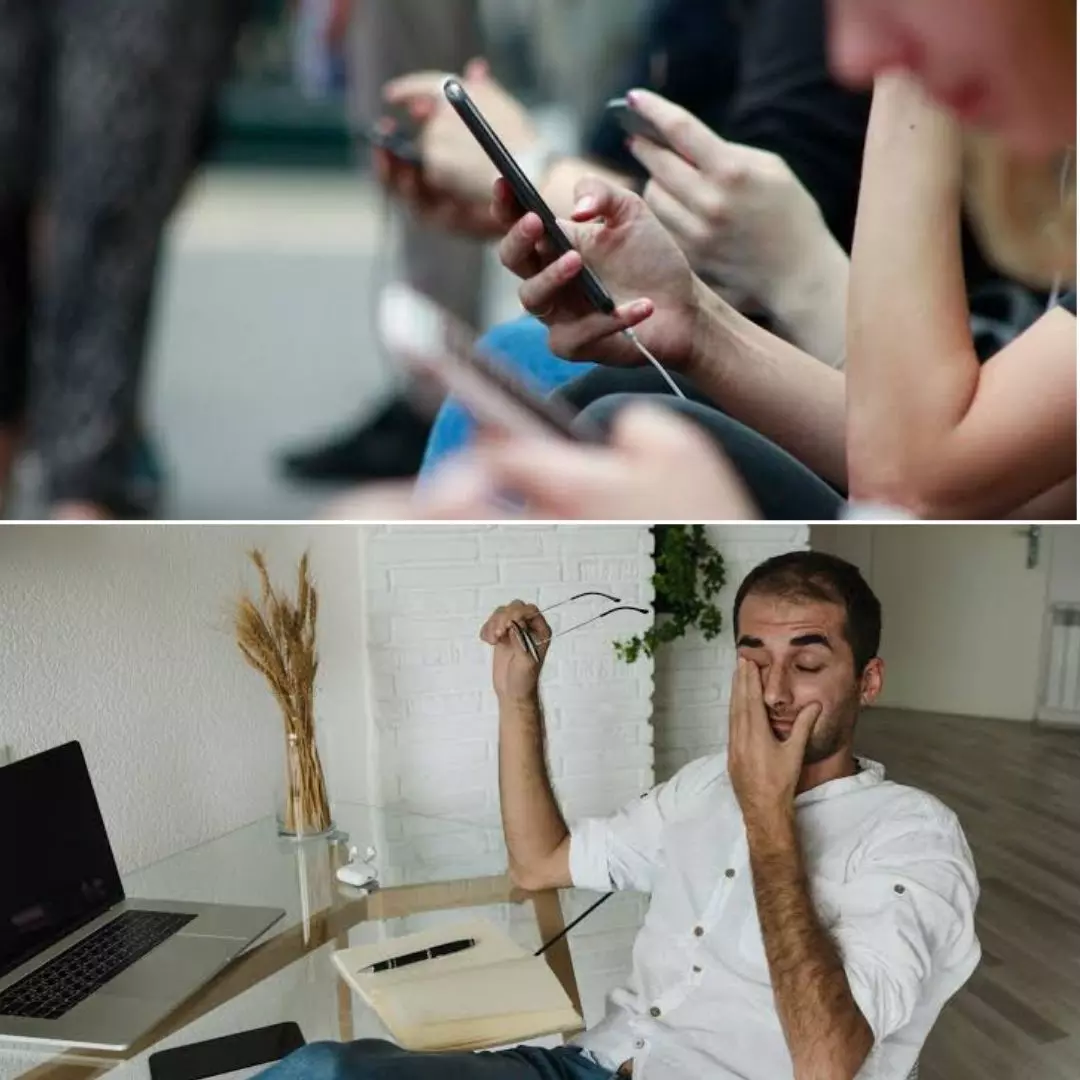
Image Credits: unsplash, sleep health
Common Habit Turned Threat! This Woman Suffered Vision Impairment For 18 Months Due To A Smartphone, Know More
Writer: Laxmi Mohan Kumar
She is an aspiring journalist in the process of learning and unlearning many things. Always up for discussions on everything from popular culture to politics.
India, 10 Feb 2023 11:06 AM GMT
Editor : Jayali Wavhal |
She writes about gender issues, human interest, and environment.
Creatives : Laxmi Mohan Kumar
She is an aspiring journalist in the process of learning and unlearning many things. Always up for discussions on everything from popular culture to politics.
Smartphone Vision Syndrome is a condition that results from a person staring at a display device for prolonged and uninterrupted periods. Here's how a 30-year-old's vision was impaired for over a year due to the common habit of staring at a phone screen.
Dr Sudhir Kumar, a neurologist with years of experience at a reputed hospital, made netizens pause with worry over a post that he recently made. Bringing to light the case study of a 30-year-old woman with vision impairment, Sudhir Kumar brought to the discussion a phenomenon known as "smartphone vision syndrome" (SVS).
At a time when learning and working are happening through digital screens, people don't have much of an option in terms of reducing screen time. This comes along with a lot of health risks, and the direct impact reflects in the vision as people strain their eye muscles through uninterrupted periods of screen time. The doctor's post explaining the syndrome through the case study and giving netizens an important message to take home is now going viral.
Blurred Vision To Polyopia
SVS or Computer Vision Syndrome (CVS), is a condition that results from prolonged and uninterrupted focusing on a display device. It strains the eye muscles in a way that causes issues with recovery from the constant tension required to maintain focus on a close object. The symptoms that then follow include headaches, blurred vision, neck pain, fatigue, dry eyes, irritation in eyes, double vision, vertigo, polyopia, and difficulty refocusing the eyes.
Talking about the health concerns that follow the common habit, the doctor took to Twitter to explain the syndrome through the case study of Manju, a 30-year-old. She had approached the hospital after almost a year and a half of experiencing severe disabling vision symptoms. The symptoms included seeing floaters, bright flashes of light, dark zig-zag lines, and at times inability to see or focus on objects. She explained to the doctors that there were moments when she could not see anything for several seconds at night.
A common habit resulted in severe #vision impairment in a young woman
— Dr Sudhir Kumar MD DM🇮🇳 (@hyderabaddoctor) February 6, 2023
1. 30-year old Manju had severe disabling vision symptoms for one and half years. This included seeing floaters, bright flashes of light, dark zig zag lines and at times inability to see or focus on objects.
An eye specialist checked the patient and ruled out any form of abnormalities in vision. They then referred her to the neurologist, who reviewed the patient history before proceeding with any tests. Dr Kumar understood that Manju worked as a beautician before quitting her job to take care of her specially-abled child. At the time, she picked a habit of browsing through the smartphone for hours, especially at night with lights switched off. This newfound habit proved harmful to her health, and the diagnosis was clear by then.
Dr Kumar concluded that she was suffering from SVS due to the long-term use of devices and chose to treat it organically rather than through a long list of prescriptions. Manju was quite anxious about her condition and requested the doctor to suggest her medicines, but the doctor counselled her about the possible cause for her vision impairment and suggested she minimise smartphone usage.
6. Manju was anxious as she feared something sinister with her brain nerves but was finally determined to take corrective action.
— Dr Sudhir Kumar MD DM🇮🇳 (@hyderabaddoctor) February 6, 2023
She said- "instead of minimizing, I will stop looking at smartphone screen, unless absolutely necessary. In any case, my phone use is recreational."
Manju took up the advice and at her one-month review following the diagnosis, she was doing absolutely fine. Dr Kumar wrote, "Her vision impairment of 18 months had gone. Now, she had normal eyesight and did not see any floaters or flashes of light. Moreover, her momentary loss of vision at night also stopped. Our suspicion was proved right."
9a. 66% of a sample had computer vision syndrome (CVS).
— Dr Sudhir Kumar MD DM🇮🇳 (@hyderabaddoctor) February 6, 2023
Being female, improper body posturing, use of electronics devices out of work, no habit of taking a break, long-hour duration of visual display terminal use & short-distance screen were associated with increased odds of CVS
Sending A Message To Every Home
The thread of tweets conveyed the problems associated with long durations of staring at the screen and gave two important messages to take home -
- Avoid looking at screens of digital devices for long, as it can cause severe and disabling vision-related problems.
- Take a 20-second break every 20 minutes you look at a digital screen to look at something 20 feet away. (20-20-20 rule).
This was a reminder for many who continue to work within the confines of the digital screen, and it reflected in the comments section with people asking for therapies for those who have to use devices for long and continuous hours.
Another concern Dr Kumar portrayed was that many cases of transient smartphone-induced blindness were reported among people using smartphones in bed in the darkness. Spectral peaks for smartphones are very similar to short-wavelength blue visible light, and the damage caused to the retina by this light is well-established through multiple studies. Several users commented that smartphones and other devices should come along with a statutory warning that these devices are harmful to the eyes and mental health.
There should be a statutory warning that smartphones or mobile devices are harmful for your eyes and mental health.. at least an alert.. have seen people use up to 5 to 10 hours a day combined for work, personal and recreation use. Eye wear companies are doing good business..
— Harsh (@harsh_in) February 6, 2023
Many systems follow this pattern, especially the gaming sectors, where they alert the user of excessive time spent gazing at the screen. Taking into consideration the user's health, multiple advanced systems have features such as locking the screen when a certain period of screen time exceeds. While these are methods through which companies and manufacturers can ensure the health of the users, it is every individual's responsibility to ensure that they take the necessary measures to ensure their health.
 All section
All section














